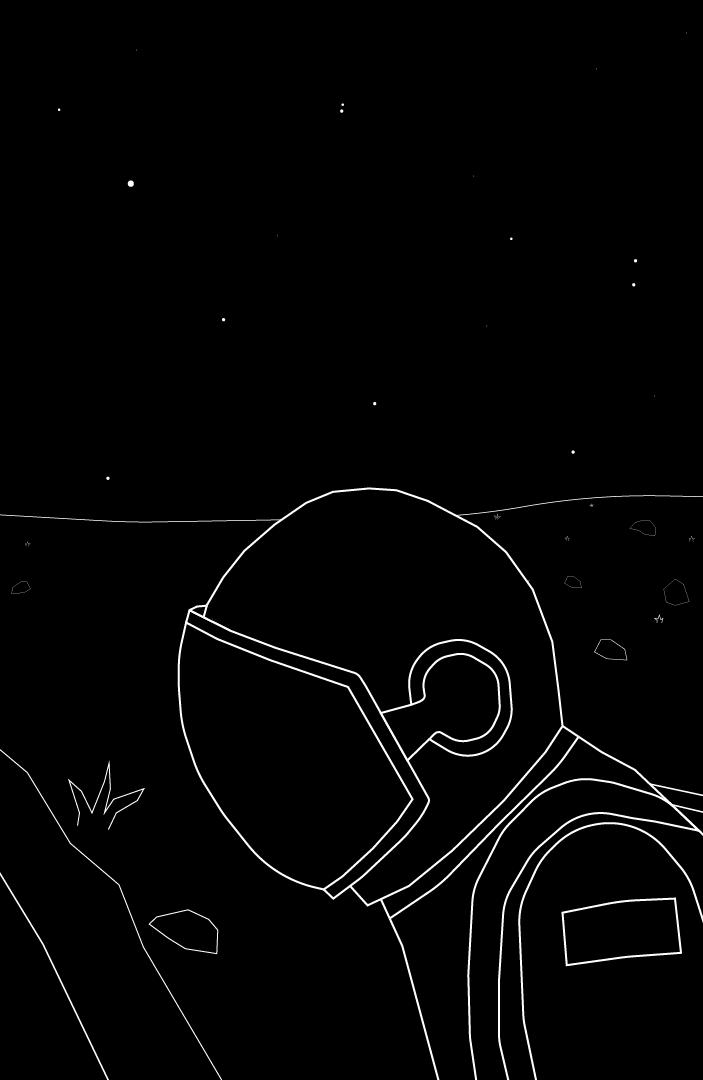
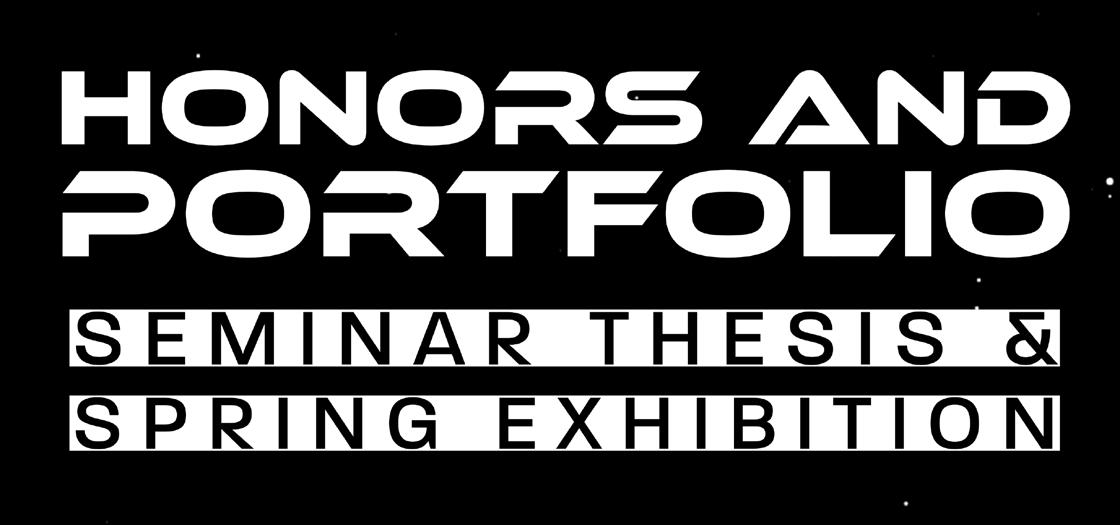
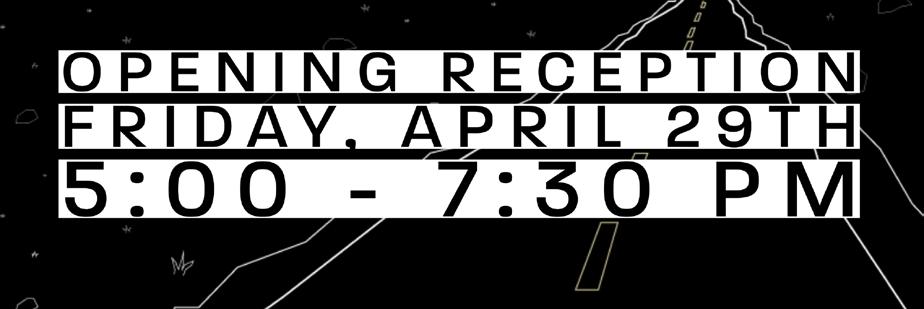
This course provides an environment for students to continue any of the introductory level art classes and can also be taken as preparation for the Honors Seminar Studio Art class. The Portfolio Seminar allows in-depth investigation of ideas and builds on the craftsmanship begun during an introductory level class. Assignments to further develop technical skills in a variety of media are interspersed with independent projects. Students play a role in developing the direction of the course and in writing their own assessment criteria. Through discussions, research, and critiques, each member of the group cultivates an artistic vocabulary and critiquing skills and is exposed to a variety of research and methods for conceptual development. Students maintain a sketchbook as their primary organizational tool for visual evolution. Topics range from community-based and collaborative work to historical, cultural, and contemporary art. The course concludes with a significant independent topic chosen by each student, such as a global art investigation, art used as activism, a personal narrative in art, documentary photography, bookbinding, portrait painting, or a video short. Students conclude the class with a portfolio of work and an artist’s statement. This is a full year or fall or spring semester course. Two semesters of this course may be taken in different years in Upper School.
Honors Seminar in Studio Art is an immersive, symposium-style course that allows committed students to work in a variety of media at an advanced level. Students cooperate in developing the course, plan a personalized course of study, and propose projects with their peers and teacher. Students conclude the year with a significant portfolio of work, creating a digital or hand-rendered sketchbook of research and an online portfolio as they progress. Through discussions, research, and critiques, each member of the group develops a broad artistic vocabulary and critiquing skills and is exposed to a variety of art teachers. The class schedule is divided among studio time, critiques and exchanges, visiting teachers and artists, and work with professionals at galleries, universities, and museums in Rochester. The course concludes with each student hanging an exhibition of their work and writing a thesis statement. This is a full year course and may be taken twice during Upper School.
Contents Lilah Costanzo 4 CARLY FREEMAN 5 NYA HAUSER 6 ELIZA NICOSIA 7 KELSEY PINKOWSKI 8 MAYA SCHWARTZ 9 Jennifer bilinski 10 Sophia Diehl 12 AVA DOUGLAS 14 Jaqueline Henry 16 ELLA PROKUPETS 18 Jonathan Ragan 20 LEE REDDINGTON 22 BEA WUN 24 RONAN WUN 26 EILEEN ZHao 28
Lilah Costanzo
BIOGRAPHY
Lilah is a junior at Allendale Columbia School. She has been involved in the visual and performing arts since she was little, and she devotes much of her free time to playing her instruments and creating artwork. Lilah hopes to continue her pursuit of the arts throughout and after high school. Some of her recent artwork has been exhibited at the “Through the Student Lens” event at the Image City Photography Gallery and the NYSATA Region II Student Art Exhibition. The works in this exhibition focus on capturing beauty and emotion through pen and paper, deeply exploring a “stippling” technique to create shapes.


4
CARLY FREEMAN
Carly is a senior at Allendale Columbia School. She is very passionate about spreading positivity throughout her community and uses her art to express that passion.
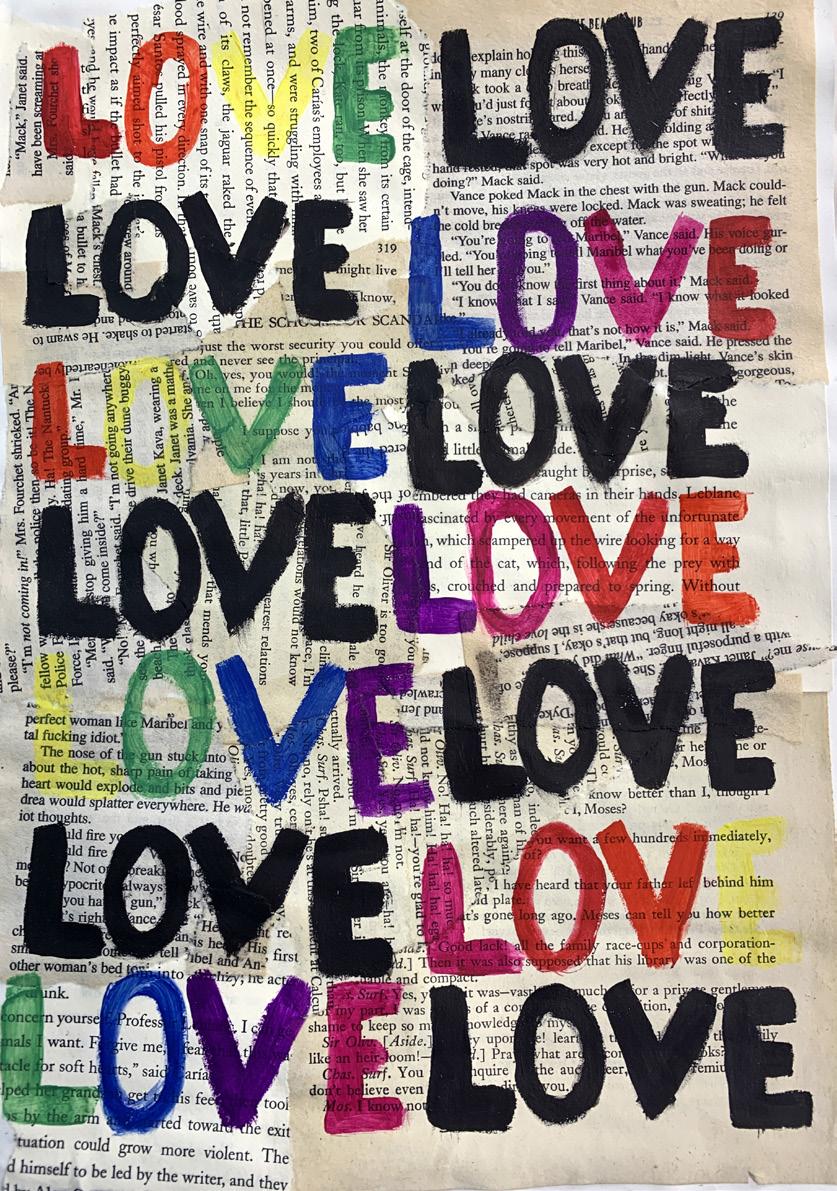
Aside from using art as a creative outlet, Carly likes to spend her free time volunteering at St. John’s Home and playing tennis. Carly is a part of the varsity tennis team at Allendale Columbia School and in her last season she helped her team compete in the state tournament. In college, Carly plans to continue her education and study psychology this fall.
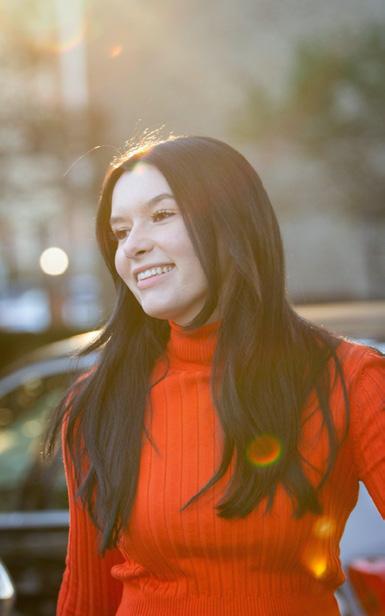
BIOGRAPHY 5
NYA HAUSER
BIOGRAPHY
Nya is a junior at Allendale Columbia School. She loves to travel and especially loves being in one place long enough to at least get a glimpse into the culture. Her favorite is Stockholm, Sweden.

Nya has loved a range of art mediums since she was little. She found her passion for photography in middle school. Her subject of interest has changed from arbitrary to portraits and now to architecture. She has done film and digital photography and loves both. However, digital photography allows her the creativity that comes with editing, which has been her focus this semester.

6
ELIZA NICOSIA
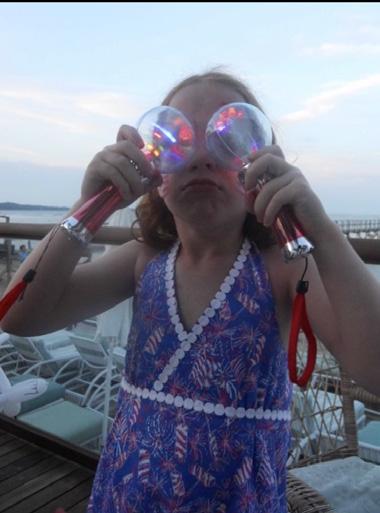
Eliza is a senior at the Allendale Columbia School and was born and raised in Rochester. She has always enjoyed art and has taken a variety of art classes during her time at AC. She especially enjoys working with clay and creating collages. For the exhibition, she created different landscapes made from watercolors and handmade paper. Outside of art, Eliza plays tennis, basketball, and softball, and will be attending Boston College in the fall.
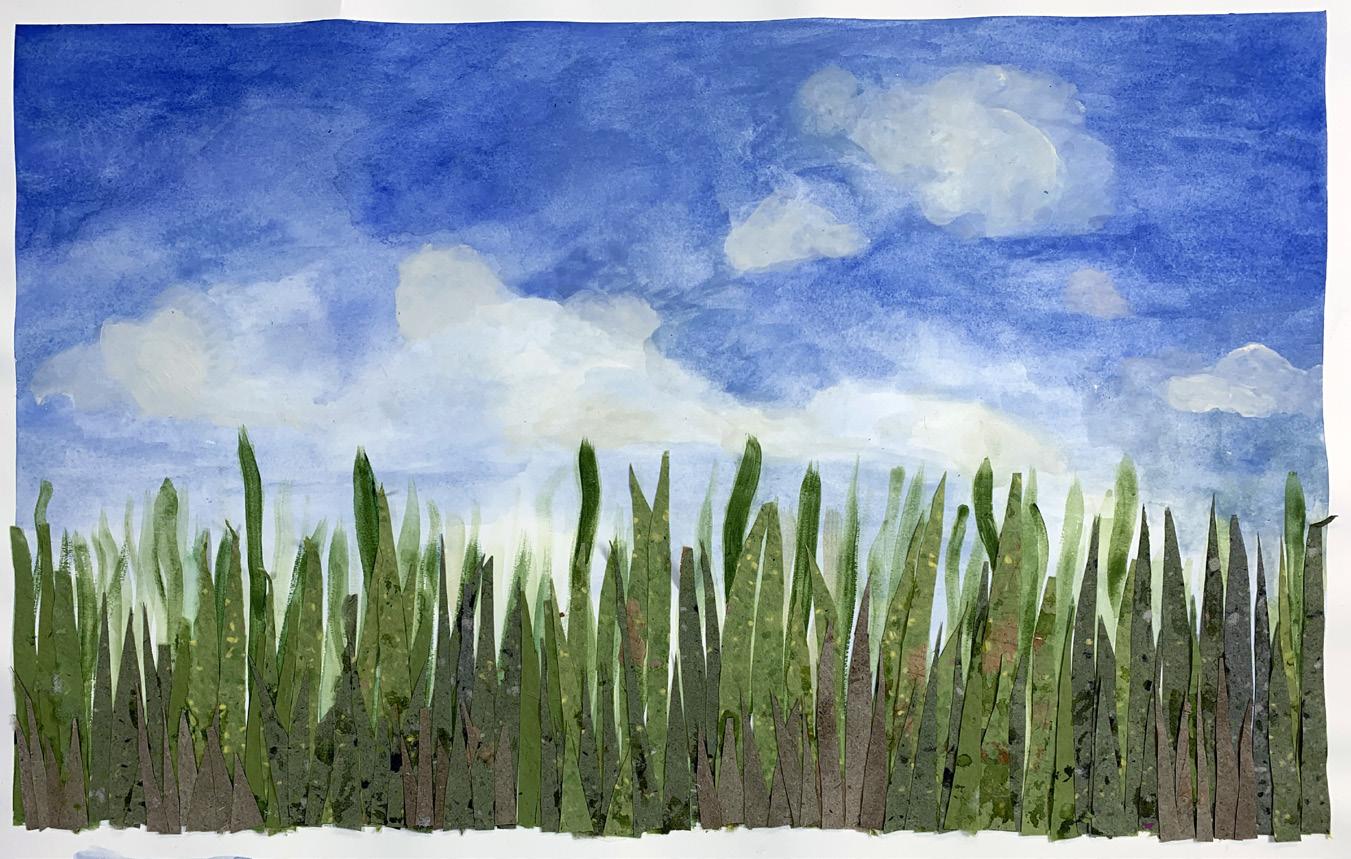
BIOGRAPHY 7
KELSEY PINKOWSKI

Kelsey is a senior at Allendale Columbia School. Through many different fun, creative, and bizarre experiences in her life, she has been inspired by the world and people around her. The work in her thesis project has been influenced by these different encounters as she tries to figure out who she is as a person and what her place is in her community.
She has recently been experimenting with different materials that she has never used before. In these pieces, she has been able to learn new techniques and ideas through self-taught sculpting (with a little extra support, of course) and inspiring discoveries. Kelsey hopes to continue her passion for art in the future.

BIOGRAPHY 8
MAYA SCHWARTZ
Maya is a junior at Allendale Columbia School. She was born and raised in Chicago, Illinois, and moved to Rochester in 2018. She loves to create digital artwork using Procreate and Photoshop, and also has a passion for digital photography and pencil illustration. Along with the fine arts, she has a strong interest in all things related to music.

Her artwork has been recognized regionally, most recently in an exhibition at Roberts Wesleyan College. She has participated in the Scholastic Art and Writing Awards and her work has been shown in multiple art exhibitions. She hopes to get her art involved in national activism someday. Her work can be found @art.above.ground on Instagram.
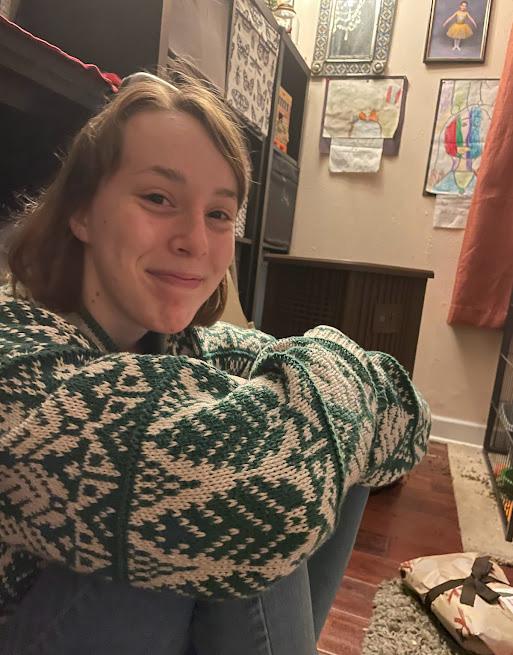
BIOGRAPHY 9
Jennifer bilinski

Jennifer Bilinski is a Senior at Allendale Columbia School. She was always the child who received art supplies for Christmas and birthdays. As she has gone through both Middle and Upper school, she has taken a variety of art classes. No matter what the medium, she managed to find something fun in each class. Jennifer has no plans to make a career out of this hobby, but definitely wants to improve on her own time.
THESIS STATEMENT
Colors of the Dark

Working with a medium such as dark charcoal required me to build confidence, which seemed fitting for a project about my ever-changing mental health. To follow the theme of my mental health, I added paint to the picture to signify some bits of happiness in the dark. These works have provided me a safe space to express my feelings onto paper. My goal is to help others find happiness in their rough patches. My therapist taught me that there will always be bumps

BIOGRAPHY
10
in the road, and to learn from each bump. In this process I have learned a more positive way of thinking about times I previously saw as sad. With that perspective being put into my art it can be interpreted in new ways by each viewer. Charcoal is an intense medium so I added light patches to keep the eye flowing. I’m curious to know what others take from my art.
At the beginning of this process, I was overwhelmed by each path I could take with my idea. I sat down and looked through art made by artists who focused on charcoal. While in that process, I learned about water charcoal. Mixing water with charcoal was something I had never thought of before. I immediately started practicing with mixing paint and wet charcoal to get an idea of how it works. After that I started brainstorming how I would put copious amounts of thoughts onto paper. Nothing came to me for a while and I just started painting with charcoal. Each day new ideas would flow onto the paper and I eventually came up with my piece. When that idea ran dry I moved onto a more complicated piece: a portrait of how I view myself compared to the real me. Sketching this final piece felt like I was combining my knowledge onto one canvas.
I want people to walk away from my art with new ideas about feeling hurt. I expect questions, but I also see some just standing and thinking. Mental health is a subject that needs to be talked about in a positive light. I am not the best talker, but I do enjoy art. Art is a happy place for me, and I enjoy coming in to work on it each day. I have noticed my outlook on my past year has changed; while others may not have this reaction I hope they think about it. With the large amounts of darkness in this piece it leaves the eye to fill in what it thinks should be there. This is the imaginative part of my piece which I think will be unique to each person. Some may even leave it dark.
11
Sophia Diehl
Sophie Diehl is a senior at Allendale Columbia School. Sophie began taking an interest in art at a very young age, and has worked in a variety of mediums. Quite interested in experimenting and pushing her limits artistically, she often strives to try something new.

Sophie has participated in many Evening of the Arts events at Allendale Columbia School, as well as Allendale Columbia’s Empty Bowls event to raise money for charity. Many of her works have been featured in exhibitions, including two pieces honored with awards in RIT’s “Start Here” shows. Sophie has also received two Silver Key Scholastic Art Awards. She hopes to continue her work in art in the coming years, and will be attending Ithaca College this fall to study Theatre Production and Design.
THESIS STATEMENT

Throughout my artistic endeavors, I have created art simply for the purpose of creating. Due to this, I have always felt a sense of distance from my art—a fairly ironic state since art has always been a form of expression for me. There was always an invisible wall between me and the existence of my work. Even so, I never really thought much about how my work shied away from connecting with my personal experiences. I just tended to make things that I thought looked cool or interesting. This time, as my last major art project before college, I wanted to create a piece that meant something to me. Though I hadn’t always planned on doing a personal project, due to the circumstances I found myself in this year, and working through those times, I established a sense of closure for myself— making something worth looking at out of the awkward, not-always-so-beautiful process of growing up and changing. How things are not always unconditional.
Nostalgia is also something that has had a big impact on my life, and something that has always meant a lot to me, which is why I ultimately decided to pick a project that would center around that sense. The nostalgia that I wanted to capture through this piece has roots in events from some meaningful moments in my life, struggles, turning points, and what I was able to glean from them. Though they have not always felt positive in the moment, they have made me who I am. I have been working through a lot of my anxieties this year, and I am continuing to actualize them further. Identity is also something that I have slowly started prioritizing in my life, and the development of who I am, and know myself to be. I see this project as my small way of finding my voice.
BIOGRAPHY
12
Throughout the construction process of the project, I worked with several mediums— all of which have roots in different skills I have worked to develop throughout high school. For example, last year my focus was on painting, and ultimately painting on fabric. I have also been working on ceramics since middle school, and wanted to mix the sense of a solid piece with fluidity, which I found in the fabric. The mediums I chose were also a little homage to my growth as an artist and as a person.

I learned a lot about ceramic construction, painting, and myself through this process— one of my most significant takeaways from the project was being patient with myself, and the ability to pivot when something doesn’t feel right or true to my vision. There were several times during the construction process when I decided to revise my original plan. To change the composition, meaning, and scale to be as I wanted it to be. I needed to be understanding with my process, and try not to get stuck in doing the original plan, to understand that things take time. As for more technical takeaways, I think that further exploring acrylic on fabric has been instrumental, and that any experience to further my ceramic abilities is always worthwhile.
My greatest hope is that even though this project is deeply personal to me, that others can connect with it as well. To find their own meaning, or see something that they feel or have felt reflected in the piece. I have so enjoyed the process of this project and welcome the new skills I have developed.
AVA DOUGLAS

From Webster, NY, Ava is a senior at Allendale Columbia School. Ava has been interested in photography since the sixth grade and has combined her love of reading and writing with photography as she has pursued some projects in photojournalism. This year, she decided to dive more into digital photo editing. Aside from photography, Ava is passionate about music and dance. She has been a dancer for 12 years, and she spends her free time assistant directing and stage managing theater productions. This year, Ava has taken on the job of HAC Sports Photographer and has taken team photos and candid shots of the HAC Sports teams throughout the school year. Ava’s photography has been featured in the annual “Through the Student Lens” high school photography exhibition at Image City Photography Gallery. She hopes to continue studying photography throughout the rest of high school and throughout college. Ava plans on attending RIT in the fall, majoring in Criminal Justice and minoring in Political Science.
THESIS STATEMENT

Over the course of my art experience at AC, photography has always been my medium of choice. I have done a lot of work with portraits and photojournalism, and this year I wanted to do something much different than I have done before. I decided to continue with some portrait work, but I combined these portraits with Adobe Photoshop techniques to morph my subjects’ faces. My thesis project explores the human facial structure and how it can be altered to appear much different.
A lot of my experience with photography has been with black and white film. It was very manual and traditional, and I did not do a lot of digital editing. Teaching myself how to successfully utilize Adobe Photoshop to create my pieces was a struggle. I experienced a lot of trial and error, but I was determined to do it. I took digital portraits of my friend, Jon, and then put them into Photoshop to see what could happen. I played around with layering, light, and illusion to create unique portraits. Although they are each of the same person, the pictures are very different from each other.
BIOGRAPHY
14
While working on this project, I learned how to edit with Adobe Photoshop. Starting with a software I had barely touched before was definitely a challenge, but it was a challenge that I had a lot of fun with. This project also allowed me to see facial structure through a different perspective, as I spent a lot of time working with different facial features. This project has inspired me to do more work with digital photography and editing in the future, and I would be interested in doing something like this again.
 Jaqueline Henry
Jaqueline Henry
Born and raised in Rochester, Jacqueline is a senior at Allendale Columbia School. Drawn to art in all its forms as a child, she could be found drawing at any given moment (and maybe even in the not-so-given moments). Whether in her first real sketchbook or in a restaurant on the back of a paper placemat, she has always found joy in translating into real life the things from her imagination. Jacqueline has since attended many art classes inside and outside of school in order to hone her craft and has had the honor of having her work displayed in multiple shows. She was awarded two Gold Keys in the Scholastic Art and Writing Awards for ceramic sculptures “Supplicant” and “Engine Tester”, the latter work also being featured in the 32nd Annual Legislative Student Art Exhibit; photograph “Vidalia” was displayed at RIT’s Start Here 2021 exhibition. Jacqueline has dabbled in nearly every available medium, having spent time working in clay, colored pencil, charcoal, pastel, and photography. She aims to continue her exploration of art at Connecticut College this fall.

THESIS STATEMENT

As a senior, now in a position to reflect on all the art that I have produced over the years, a pattern becomes apparent. As seen in my junior thesis project, in which I attempted to perfectly draw from life different mechanical items, I am a stickler for control. My process can be very slow and tedious, often yielding what seems to me to be not nearly enough output for all of the hard-wrought input. My senior thesis now takes a direction in which I rarely go: it centers around the idea of art truly being a journey all its own, and of leaving things up to chance. Pencils and plans were largely forgone this time, with wood cleaner, shaving cream, baking soda, dish soap, and light serving as the facilitators of my medium. Making chemigrams allowed me to explore a process entirely new to me and to create images I would have never otherwise, introducing me to a different way to approach the creation of art.
Like most ideas I end up sitting with for weeks on end, I stumbled upon chemigrams in a roundabout way: searching for alternative methods of photography that I intended to incorporate into another project entirely. Chemigrams intrigued me the second I saw examples of them, as they largely didn’t focus on recreating any actual “image”. They were conceptual, unpredictable, and had something unplaceable about them. While this was my first venture into making abstract art, I have always been drawn in by the strange recognition of entirely foreign images that it can invoke.
BIOGRAPHY
16
Generally made from exposing photographic paper to a slew of household items to then dip in developer and fixer, the results of my work were dependent on the factors of light and time. What I found that I enjoyed so much about chemigrams was their ability to look vastly different depending on the methods used to make them—even then, I found that attempting to recreate the effects that appeared on one image on another to be nearly impossible. This was far from being a negative, though, as each new iteration revealed something unique and interesting that I would then explore further. Some manifested into visions of far-away clusters of stardust, turning into nebulas and comets trailed by tails of light; some appeared as the dregs of a longforgotten vat of industrial chemicals, pure pollution changed into something beautiful only from the passing of time.
While striving for perfection is often seen as a positive, I have found that it causes just about as much harm as it does good. Perfectionism can be the driving force behind art that is either stunning or starchy, but moving past such a mindset can end up creating work that expresses a special sort of freedom and naturally bends beyond the imagination. There is much delight to be found in making chemigrams—in waiting to see how the developer fades new colors onto the image and how bright spots of fixer show through layers of pink and gray. As opposed to fighting against randomness, I worked with it, and created pieces that I hope will cause people to stop and consider the beauty that can be found in transience.

ELLA PROKUPETS
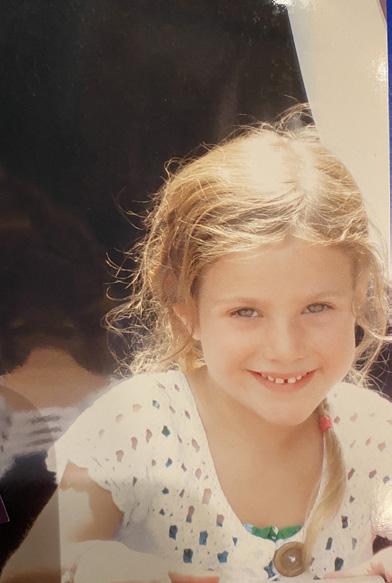

Ella is a senior at Allendale Columbia School. She has taken many art classes throughout high school and enjoys learning new things each year. Last year, she mostly focused on painting and improving her watercolor skills. She usually paints with vibrant colors in different patterns or with natural subjects. This year she has wanted to expand her art horizons by trying new things and learning new techniques while improving the old ones. Outside of art, Ella likes to ski with her family.
THESIS STATEMENT
I’ve always loved creating art with vibrant colors, and trying new things. For my thesis project, I have made a mosaic with different colored glass and learned how to cut it and put it all together. This is nothing like anything I’ve done before which is why it interested me so much.
I really wanted to explore a topic very different from everything else I’ve done, while still incorporating a lot of the same aspects. Some of the things I like to include in my art are vibrant colors and bold shapes that tend to follow specific patterns. I have not worked with 3D art much, and I wanted to try and create physical art while still using a lot of the floral patterns that I usually do with my paintings. I also wanted to be able to create something I could use for a long time.
BIOGRAPHY
18
Creating this piece of art has been all about the process for me. Every step has been a new technique to learn. The whole project started with me watching YouTube videos on how to cut glass using tile cutters. I cut all the stained glass pieces into floral shapes which was time consuming and hard to perfect. The next challenge was creating the huge wooden circle I needed to use as my background for the mosaic. I knew my dad would know how to cut the wood but it was more challenging than I thought. We had to figure out how to make the most perfect circle possible. We ended up using a nail and string to measure out a 30 inch diameter and tracing the circle to cut it. It was so interesting the amount of new skills I could learn through just one art project.
The whole process was fun, challenging, and an overall learning experience. I’m really excited that I was able to complete a project like this full of skills I had to learn in the process. Sometimes getting out of your comfort zone is the best thing you can do.

Jonathan Ragan


Jonathan Ragan is a senior at Allendale Columbia School. He lives in Fairport, NY, but loves to travel (although he has never been on a plane). Road trips to California and back as well as Canada made him an avid traveler who constantly enjoys being in and around nature as well as exploring new places. Ever since he was little, Jonathan has always been interested in film. Grabbing a VCR camera, he would parade around the house documenting whatever he could. Jonathan loves movies, and the hundreds of films he has seen over the years continue to inspire him every day. Some of his favorite films are: Prisoners,LaLaLand,Taxi Driver,and TheRevenant . Jonathan has made several short films, and has received two Gold Keys from the Scholastic Art and Writing Awards, as well as most recently, the Visual Storytelling Award from RIT’s “Start Here” exhibition for his short film DITTO. Jonathan plans on attending RIT in the fall.
THESIS STATEMENT
I have always been interested in filmmaking. In high school, one of the main challenges I have had with making short films has been finding a cast and crew to help. For my thesis project, I wanted to find a way to create a short film that I would be able to make in a controlled environment while I was able to manage and change different aspects as I saw fit. The conclusion that I came to was that with stop motion animation, I could literally create anything. As I brainstormed ideas, I began thinking about different things that were important to me. After narrowing it down, I came to the idea of nature and pollution. I have always loved nature, and I feel like now is a great time to highlight its beauty and the effects that pollution has on it.
To begin my project, I needed an idea. I wanted to find something that I was both interested in and passionate about, where I could convey some form of message. Usually, I have a hard time coming up with ideas that actually mean something, so the brainstorming process was very difficult. After some time, I came upon images of abandoned cities and buildings where nature had reclaimed certain areas once the humans had left them. When tackling the idea of stop motion, one of the most essential parts that cannot be overlooked is the planning phase. I would say that nearly 50% of the entire project was made in the planning stage. Some of the many portions that went into the planning stage were the logistics behind the set building, as well as how each shot would unfold through a storyboard.
BIOGRAPHY
20
Once I had figured out the basic idea--nature being disrupted by the outside world with pollution, and then reclaiming itself, I had to think of the characters and systems that I would utilize to bring my idea to fruition. I figured that stop motion would be the best way to start my process with this short film. I would be able to control all of the factors of the set, characters, and any outside influences that might otherwise prove problematic. After I built the set (with the help of Adam Rogers creating an amazing backdrop,) I was able to start filming. To film, I used the DragonFrame Technology, as well as Premiere Pro to edit it. The final stage of the process is integrating music into the short film. To do this, I will be utilizing the help of my brother Andrew Ragan, who is an experienced compositionist for many short films.
This process has been difficult and time consuming, and it has been the biggest and closest thing to a “real” short film that I have made so far. I wanted to create something that was meaningful to me, and I think that this one sums it up quite well. Some of the biggest challenges along the way were trying to figure out how to light the space, building the set, and finding an ending for the story.

LEE REDDINGTON

Lee is a senior at Allendale Columbia School. He was born in New York City, and moved to Long Island for his first ten years, before settling in Rochester. Lee discovered art in the summer before sixth grade, when he found cartoons and drawing, and realized that it was something he wanted to do.
Lee has taken a class in anime drawing at the Memorial Art Gallery and is planning to attend the Maryland Institute College of Art this fall. His favorite thing about art is that it allows him to convey emotions and expressions on people’s faces. When he is not working on art, Lee is an avid figure skater.

THESIS STATEMENT
My thesis is about the art of layering and how perspective can affect the way a piece looks. I chose to use resin because it has the ability to create thick layers for the best results. I chose this topic because I have worked with resin in the past, but not on this large of a scale. I also wanted to push myself while also using the previous knowledge I have with making portrait-style pieces and resin and I want to see what I can do with both these ideas.
The process of each of the pieces was very lengthy and varied from each piece. First, I would start by making a background by pouring different colors of resin on top of a wooden block. To prevent the resin from spilling over, I used aluminum tape and taped the sides to make a barrier for it. I would do this for most of the layers except the final one since it was so thin that it wouldn’t spill over. After the resin had cured, I would take a picture of it and transfer it to my computer, then using a digital illustration program (Clip Studio Paint), I would draw a portrait style illustration and use the layers feature on the program to plan out what layers would be where (ex: color, shading, line art, etc.). Then, I would pour a layer of clear resin over the colored background layer. Then I sand that layer down so I can have a surface that’s easier to draw and paint onto. I start with the base layer, which is painting the body and face. I don’t add any outlines to this layer because when I do the outline on another layer, it adds to the 3-D effect. After I paint it, I pour another layer of clear resin and sand it down. This is the layer that I do the line art on. I create the line art with colored pencil and paint markers. After that, I do one final layer of clear so everything looks glossy and adds to the 3-D effect more.
BIOGRAPHY
22
The main concept of this project was to try and create as much of a 3-D effect as possible using the thickness of the layers of resin. I chose to use resin because I had a bit of experience with it, but only on a much smaller scale. I also wanted to make something that had physical depth to it and looked different from different angles.

BEA WUN

Bea is a senior at Allendale Columbia School. She has two art teachers for parents and only realized in her final year of high school that art was pretty cool. Bea’s as nerdy as they come and will gladly tell you why video games count as art mediums if you’re not careful. She’s going to college to study video game design next year, so she may be biased.

Bea learns new things quickly and loves to create. She almost always has a hundred projects going at the same time, and will regularly pick up new ones. Many of them get finished, and many do not. Most notably in the past, she created a game in two weeks for an amateur game jam that won an honorable mention: https://dayglo123.itch.io/space-adventure
THESIS STATEMENT
2021 kicked my a$$ while also giving me a lot to think about. I’ve realized just how important it is to have support, and to persevere when things get tough. Having people to talk to has made my journey through exploring my gender identity and high school in general so much easier, and given me confidence in myself and my ability to succeed. I wanted to show a little bit of that. I wanted to explore those ideas in a medium I love, animation.
BIOGRAPHY
24
When I started I wanted to focus on intentionally designing characters and shots to evoke certain moods and feelings instead of figuring it out as I went. I wanted everything I did to have at least a little bit of a reason behind why I did it in the way that I did. One of the most important things I’ve done in that respect is to create characters that don’t have an easily discernible face. There’s something about looking at a character that doesn’t have facial expressions that allows each viewer to understand them a little differently. The deep emotions and feelings have to be gleaned from context and body language and it’s a design choice that I wanted to have in my project from the beginning.
25
RONAN WUN


Ronan Wun is a senior at Allendale Columbia School who loves movies. He also likes stylistically-unique mediums, and this is exemplified in his thesis, where he tries to use style to convey genres. He plans to study film in college.
Ronan has won a Scholastic Art Silver Key Award for his photography, and his work has been shown in Image City Photography Gallery and in RIT’s “Start Here” exhibition. He likes photography, and has even taken a class from a Pulitzer Prize-winning photojournalist, but wishes he had more experience in learning about and working in film. He is excited to get the opportunity to do more work in cinema in college.
THESIS STATEMENT
I’ve been a massive fan of movies ever since I was a kid, and in the past few years, I’ve noticed that I love really stylized movies like TheLighthouse,GreenKnight,MissionImpossible:Fallout, and HarryPotter . I think that if you can guess the movie’s genre from just one frame, you know that it has a good style. So I decided to see if I could make a series of a few photos that evoke a genre just from one frame.
I endeavored to look at the most expressive movies I could find, and after finding some that I really liked, I thought about ways I could take photos that evoke the genre I wanted. I gathered readily-available props to use and planned my shots. Then I collaborated with my friends and took pictures of them in the scenes, as if I were shooting a movie. I originally had started on an entirely different thesis project, so my timeline for this has been a little bit condensed, but throughout a few weeks, I had worked hard on getting these pictures done. I want to convey my love of movies with this project, and help develop my own sense of style in photography and eventually, filmmaking.
BIOGRAPHY
26
While creating this piece, I reflected a lot about who I am today and where I’m going with my life. In extension, I’ve been able to reflect on my relationships and appreciate the people who have been there for me in my life. There’s a lot going on in my project, but most importantly I want people to realize that the “grand scheme of things” that everyone goes on about is nonsense. I’m not referring to religion or outlook on life or anything, I mean the universe. There is no innate significance ascribed to anything that exists. It just is. It’s a big cosmic machine way bigger and crazier than anyone can ever understand. Go and spite everything in existence by finding significance in what you do, and the experiences you have. Any significance you find in what you do is by definition infinitely more significant than the universe itself, and I think that’s pretty cool.

EILEEN ZHao

Eileen is a senior at Allendale Columbia School. She studied art since the age of 5 both in and outside of school, so she likes to describe art as her “second language”. She deeply believes that having a true passion, which is art, can keep her from boredom for the rest of her life. She loves to visit art museums, and she is also very interested in art history. She has strong passions for dimensional worlds, artificial intelligence, and everything that’s far from reality, which are reflected in her thesis project. Most of Eileen’s art is inspired by her imagination and originated from her curiosity. She also refers to her dreams a lot in her earlier works. She takes notes of the full details of her dreams if it is unrelated to reality because she somehow believes that she may use it in the future, either in scientific research that helps to disapprove her eccentric ideas or in more artworks that appear to be strange but meaningful to her, one way or the other.
THESIS STATEMENT

In the dimensional world people define, points are connected into lines, and surfaces consist of lines. Therefore, everything our eyes can perceive are two-dimensional curves (aka lines) in nature. Dancers are all about the curves of their muscles, great literature is written in strange symbols before they are given meanings, and the children, who are arguably the most intelligent age group, only draw with lines, even when they are trying to fill a block with colors. Other than a tesseract, which our eyes cannot capture yet, I cannot think of something that is not made of lines. For my thesis project, I want to explore the shapes and structures of objects around me from a fixed point of view, convert them into lines, and put them together to create a series of nine monochrome digital drawings.
The work process is simple; I used Procreate so I drew on my tablet. Rather than observing one object from several perspectives like Picasso, I looked closely at several objects from one perspective, and it is usually somewhere I feel comfortable sitting or leaning on, so I can sit there for a longer time. Rather than intentionally use color blocks like Rothko, I used only lines. In each drawing, I used matching harmonic colors on the color wheel with some adjustments on the brightness to create a balanced picture while still keeping the contrasts between the lines and the background. In this series of digital drawings, I try to use more complete lines and less short lines that are just floating around in order to avoid the “fragmentary” and “sketchbook-like” feeling. The method I used to look for the most essential lines to portray an object is to stare at it for an extended period of time. By the time I am ready to put what I observed into lines, I may forget the functionality of the particular object; I may forget who that belongs to; I may forget whether it needs to be repaired, cleaned up, or stored in the cabinet, because it becomes just lines. Lines are boring because it doesn’t involve saturation of colors or any special effects from
BIOGRAPHY
28
the texture, but lines are also fascinating because they express so much with so little; they jump out of the paper and catch attention with their intricate pattern.
The main idea of this series of drawings can be very broad, but I also came up with an explanation that brings the drawing some physical functionality. Once the memory storing machine is invented, I can bring all the junk and all my useless objects with me. For some people, decluttering may be a part of their routine, but for the rest of the people, they like to store things with sentimental values. Because I am very used to my living environment, it may make me feel strange without them, so having them simplified into lines and stored digitally allow me to come back to this room and this lifestyle I used to have at my age. Anyways, I really want a self-cleaning room before all that happens.






-






















 Jaqueline Henry
Jaqueline Henry

















